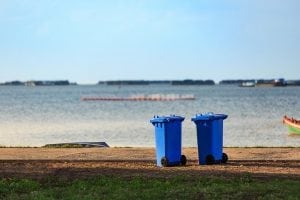 In certain circumstances, having households bag recyclables and leave them at the curb might be a better option than using carts or bins.
In certain circumstances, having households bag recyclables and leave them at the curb might be a better option than using carts or bins.

 Associate Editor Jared Paben has worked for Resource Recycling since December 2014. Most of his earlier career was spent as a reporter for the daily newspaper in Bellingham, Wash., but he also has experience working for the Oregon volunteerism commission and for Oregon nonprofits serving low-income populations. He can be contacted at [email protected].
Associate Editor Jared Paben has worked for Resource Recycling since December 2014. Most of his earlier career was spent as a reporter for the daily newspaper in Bellingham, Wash., but he also has experience working for the Oregon volunteerism commission and for Oregon nonprofits serving low-income populations. He can be contacted at [email protected]. In certain circumstances, having households bag recyclables and leave them at the curb might be a better option than using carts or bins.
In certain circumstances, having households bag recyclables and leave them at the curb might be a better option than using carts or bins.
 Ontario’s Niagara Region sells its recycled glass for use as sandblast media, but what happens if that market slows? An initiative aims to develop a new market for the post-consumer material.
Ontario’s Niagara Region sells its recycled glass for use as sandblast media, but what happens if that market slows? An initiative aims to develop a new market for the post-consumer material.
 MRFF has found a MRF.
MRFF has found a MRF.
The Materials Recovery for the Future (MRFF) project will partner with a Pennsylvania sorting facility to generate bales of flexible plastic packaging (FPP). Continue Reading
 The Closed Loop Fund will provide financing to boost production of fiber-based insulated food packaging, with an eye toward reducing the amount of foam polystyrene entering MRFs.
The Closed Loop Fund will provide financing to boost production of fiber-based insulated food packaging, with an eye toward reducing the amount of foam polystyrene entering MRFs.
 During their regular schedule, employees of the MRF near High Point, N.C. work on one shift during daylight hours, sorting and baling residential recyclables.
During their regular schedule, employees of the MRF near High Point, N.C. work on one shift during daylight hours, sorting and baling residential recyclables.
 Canadians recycled slightly more plastic in 2016 than they did the previous year. That’s according to a report released shortly before a Canadian plastics group unveiled its recyclability and recycling goals.
Canadians recycled slightly more plastic in 2016 than they did the previous year. That’s according to a report released shortly before a Canadian plastics group unveiled its recyclability and recycling goals.
 Global health and medical products company Johnson & Johnson says it might fail to achieve its packaging recyclability targets.
Global health and medical products company Johnson & Johnson says it might fail to achieve its packaging recyclability targets.
 While single-stream is now the norm in collection and processing in many parts of North America, one Canadian region is finding success by putting a focus on keeping fiber and containers separated.
While single-stream is now the norm in collection and processing in many parts of North America, one Canadian region is finding success by putting a focus on keeping fiber and containers separated.
 A $1 million grant from the Coca-Cola Foundation will kickstart a program to buy lidded recycling carts for coastal U.S. communities.
A $1 million grant from the Coca-Cola Foundation will kickstart a program to buy lidded recycling carts for coastal U.S. communities.
